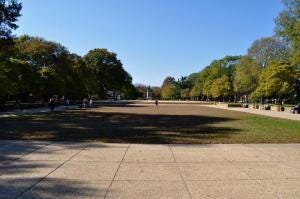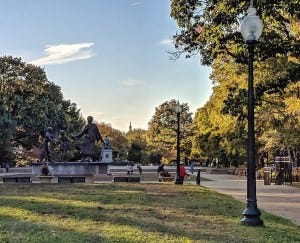Capitol Hill Rag Will Publish Lincoln Park Poems
[audio mp3="https://theworldaccordingtocosmos.com/wp-content/uploads/2025/07/Capitol-Hill-Rag-Submission-2025.mp3"][/audio]
Capitol Hill Rag, the monthly newsletter for the Capitol Hill district in D.C., will publish four of my Lincoln Park Poems—plus Summer in D.C. Haiku—in their next issue, due in August. I’ll update this later with the link once it’s available. You can read the Capitol Hill Rag online at HillRag | Capital Community News.
Capitol Hill has changed dramatically over the past decade. It’s now a vibrant, lively, hipster neighborhood. We’ve owned a classic row house on East Capitol Street since 2015, and I lived there during my assignment with the State Department. I plan to move back in a few years’ time.
Lincoln Park has always been one of my favorite little parks in D.C. Back in the bad old days, it was an open-air drug market, and there were crack houses nearby. Those days are long gone. Capitol Hill used to be majority African American; now it’s majority white, and the average home price is close to a million dollars. It’s always had a fair number of congressional staff and members living nearby—and it still does. Many of the newer residents are lawyers and lobbyists.
The neighborhood is poised for significant redevelopment as the D.C. Commanders return to RFK Stadium, just a few blocks away. The site will be extensively redeveloped with housing, retail, the new stadium, and hotels in the coming years.
Here, then, are my Season of Lincoln Park Poems, written a few years ago, and my Summer in D.C. Haiku:
Four Lincoln Park Poems
Summer
Lincoln Park shines bright
in the summer,
The beating heart of the Imperial city,
On Capitol Hill, just blocks away
From the homes of the power elites.
Tall trees stand guard
Over the humans and their dog masters.
The trees have heard things,
Seen things—yet remain discreet,
Being trees, after all.
The park slumbers on
As the humid sauna of the day
Gives way to a tropical night.
Fireflies emerge,
gossiping with the trees and flowers
About what fools these mortals are.
As Capitol Hill residents retreat indoors,
Their air-conditioned classic row houses
Stand guard over the park.
Autumn
Autumn leaves fall
All around Lincoln Park,
At the center of the universe.
The trees shed their leaves,
A riot of brilliant color in the autumn light.
Part of the annual display,
God’s masterpiece,
A show for humankind
and their dog masters.
Nearby, self-proclaimed
masters of the universe
Are too busy saving the world
To pause and take
In Lincoln Park's splendor.
Winter
As winter descends upon the city,
Lincoln Park transforms into a wonderland.
Snow blankets the ground,
And bare trees shiver in the cold.
The trees recall a time,
Not too long ago,
When Lincoln Park
Was an open-air drug market,
And crack houses stood nearby.
Those days are long gone.
The average home now
Sells for over a million dollars,
And the old African American community
Has largely been replaced by wealthy white residents.
But the trees remember—
And they mourn the loss.
The newcomers, nice enough,
Barely notice Lincoln Park.
Too busy in their important lives
To stroll through the winter’s quiet beauty.
The trees wish they could speak—
They have so much to say.
Springtime
My favorite season
In Lincoln Park is springtime,
When the park bursts into bloom.
Cherry blossoms, fresh green grass,
A welcoming sight for humans
And their dog masters.
Springtime breathes new life
Into the neighborhood—
Dogs walk their owners
Through the park,
People embrace the moment,
Filled with warmth and possibility.
Winter’s darkness fades,
And hope returns.
Cherry blossoms
begin to snow,
Petals littering the ground,
Reminding us all
That nothing lasts forever.
Lincoln Park, transient in nature,
Reflects the rhythm of the Imperial city.
Few remain for long—
The cycle continues.
But the trees endure,
Silent witnesses
To the passage of time.
Summer in D.C. Haiku
Summer in D.C.
Hot, humid, tropical days—
Madness on TV
Capitol Hill Background Info
Co-Pilot provided background info on Capitol Hill neighborhood.
Here's a detailed snapshot of the Capitol Hill neighborhood in Washington, D.C., based on the most recent available data:
🧍 Total Population
8,745 residents live in Capitol Hill
Area: 0.519 square miles
Population density: 16,839 people per sq mi
👥 Population by Race
Race/EthnicityPercentageWhite59.9%Black or African American24.8%Asian4.2%Hispanic or Latino7.1%Native American0.1%Other / Mixed3.9%
🚻 Gender Breakdown
GenderPopulationPercentageMale4,41650.5%Female4,32949.5%
📊 Age Distribution
🏘️ Lincoln Park (Population ~7,763)
Trends Over the Last Decade:
Population Growth: Modest but steady, reflecting stable residential appeal
Median Age: 37 years — slightly older than Capitol Hill, suggesting a mix of professionals and established families
Racial Composition:
White: 74%
Black or African American: 13%
Hispanic: 5%
Asian: 5%
Household Size: Average of 2.13 people per household
Single-Parent Households: 3.39% — relatively low, indicating a high proportion of dual-income or child-free households
🌳 Capitol Hill East (Population ~13,486)
Trends Over the Last Decade:
Population Growth: Stronger than Lincoln Park, with a projected increase from ~9,164 in 2020 to over 10,000 by 2030
Median Age: ~34.8 years — younger than Lincoln Park, aligning with an influx of younger professionals and new families
Population Density: ~17,893 people per sq mi — slightly denser than Capitol Hill proper
Demographic Shifts:
Increasing share of White and Asian residents
Declining share of long-time Black residents, reflecting broader gentrification patterns
Household Composition: Similar to Capitol Hill, with a mix of singles, couples, and small families
The redevelopment of the RFK Stadium site in Washington, D.C. is shaping up to be one of the most ambitious urban projects in the city’s history. Here's a comprehensive look at what’s planned and how it could reshape the surrounding neighborhoods:
🏟️ What the RFK Redevelopment Entails
Project Overview:
A $3.7 billion mixed-use development led by the Washington Commanders and the D.C. government
Anchored by a 65,000-seat covered stadium for year-round events, including NFL games, concerts, and conventions
Target opening: Fall 2030, with groundbreaking expected in 2026, pending D.C. Council approval
Key Features:
6,000 new housing units, with at least 30% designated affordable
A public SportsPlex for youth athletics and recreation ($89 million budgeted)
Entertainment districts, hotels, restaurants, and retail zones along the Anacostia River
8,000 parking spaces and improved public transit access, including a potential new Metro station
Preservation of the Fields at RFK for community sports during construction
🌆 Impact on Surrounding Neighborhoods
Economic Development:
Estimated $4 billion in tax revenue and $15.6 billion in direct spending over 30 years
Creation of 14,000 construction jobs and 2,000 permanent jobs
Potential to host major events like the Women’s World Cup, Super Bowl, and WrestleMania
Community Revitalization:
Promises of new grocery stores, green space, and recreation centers in underserved areas like Ward 7
Improved public access to the Anacostia River and preservation of wetlands
Plans to designate 30% of the campus as parkland for passive and active recreation
Concerns & Controversies:
Local groups like Homes Not Stadiums argue the stadium is not the community's top priority, citing a lack of enforceable housing deadlines
Some residents worry about traffic, noise, and displacement, especially in Kingman Park and Hill East
The D.C. Council is still debating the deal, with a vote expected later this summer
Note: In my opinion, it would be extremely short-sighted to turn down this redevelopment project, and I do not foresee it becoming derailed.
Substack
Substack Podcast
Medium
Wattpad
Spotify Podcast










Share this post